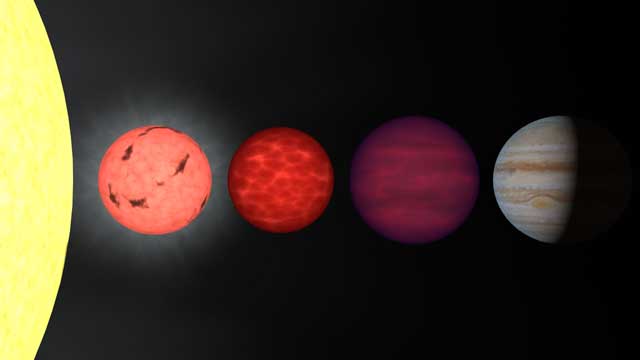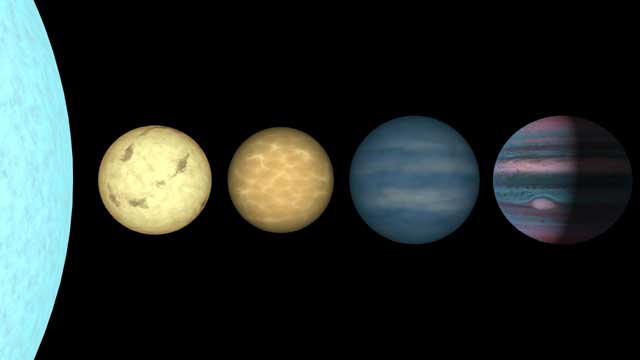An Artist's View of Brown Dwarf Types
Each figure shows an artist's rendition comparing brown dwarfs to stars and planets. All objects are plotted to the same scale. On the far left is the
limb of the Sun. To its right is shown a very low mass star (a so-called "late-M dwarf"), a couple of brown dwarfs (a hotter "L dwarf" and
a cooler "T dwarf"), and the planet Jupiter. These objects have masses ranging from 1050 times that of Jupiter (for the Sun) through 75,
65, 30, and 1 Jupiter mass for the late-M dwarf, L dwarf, T dwarf, and Jupiter, respectively. The colors of the brown dwarfs are chosen to
match an age of 1 billion years. Despite the range in mass, all four of the low-mass objects are approximately the same size, ten times
smaller than the diameter of the Sun.
 Figure 1
Figure 1
IMAGE CAPTION TO FIGURE 1
Figure 1 shows how these objects might appear to the human eye: the M and L dwarfs are red, while the T dwarf is dimly magenta, due
to lack of light -- actually absorptions by sodium and potassium atoms -- in the green portion of the spectrum.
 Figure 2
Figure 2
IMAGE CAPTION TO FIGURE 2
Figure 2 shows the
same objects as they might appear to eyes sensitive to near-infrared light. Here the M and L dwarfs are slightly orange or red
compared to the Sun, but the T dwarf is distinctly blue due to a lack of light in the "green" and "red" caused by absorption from methane.
Methane is also abundant in the atmosphere of Jupiter and this, along with the clouds and bands of other complex molecules, gives it
alternating patches of pink and blue.
ARTWORK CREDIT
Artist's renditions by Dr. Robert Hurt of the Infrared Processing and Analysis
Center.
Davy Kirkpatrick
Last Update - 26 Jun 2002


